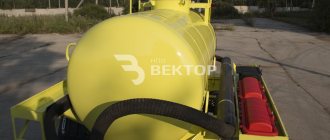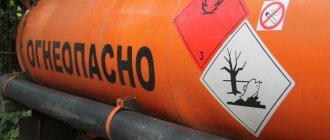Different types of activities are closely related to the implementation of a set of rules and restrictions. This is necessary for safe interaction with the population and nature of the planet. In the field of cargo transportation, it is no less carefully required to comply with the established framework, especially if the transported cargo is classified as dangerous, and its movement is associated with the risk of causing environmental harm. The presence of a special document - a certificate for the transportation of dangerous goods (ADR) helps to minimize the likelihood of the consequences of transporting hazardous goods. How the registration and receipt of ADR occurs, as well as what subtleties of the process exist, we will consider in this article.
General information about ADR
The International Agreement for the Carriage of Dangerous Goods by Road (abbreviation ADR) by road was drawn up and signed in 1957 in the city of Geneva. The Treaty prescribes the specifics of design, packaging, as well as the movement of harmful products and substances of various types of danger on the roads. The agreement is still in force and must be strictly observed in the following states:
- European Union;
- Russia;
- Morocco;
- Azerbaijan;
- those planning to join the European Union.
All countries participating in the harmonization have the right to adjust the requirements of ADR in accordance with domestic legislation. Accordingly, when planning to cross the border during a trip, it would be a good idea to clarify and take into account the adjustments regarding ADR in the destination country.
Driver's liability for violations of ADR
According to Art. 12.21.2 of the Code of Administrative Offenses of the Russian Federation, violation of the rules for transporting high-risk cargo, lack of proper clearance, incomplete set of required documents, insufficient marking of the car or its non-compliance with safety standards threatens the driver with a fine of 2,000–2,500 rubles or withdrawal of rights for a period of 4 months to six months.
The fine for less serious violations ranges from 1,000 to 1,500 rubles.
Legislative requirements for training and permitting drivers to move high-risk cargo are explained by the high risks of such transport operations. The imposed punishment for violating the prescribed conditions is not commensurate with the possible consequences of emergency situations.
Structure
The document permitting the transportation of harmful substances on the roads of the participating countries used to look like a booklet indicating current information about the driver, the vehicle and the cargo being transported. The modern certificate is a compact plastic card. Driver information and information about hazardous substances permitted for a specific vehicle to be transported are displayed on the sides of the certificate.
The ADR permit is composed of two chapters, which are divided into smaller sections. The first chapter (block A) contains information about products that are classified as malicious, as well as requirements for loading, unloading, escort and transportation.
- Basic provisions.
- Classification. Generally accepted register of dangerous goods.
- Criteria for testing containers for packaging harmful elements.
- Instructions for the container used.
- Standards for transporting unsafe products.
- Travel conditions at each stage of the journey.
- Procedure for registration and receipt.
The second part (block B) contains information about the vehicles used, as well as additional equipment.
- Employee certification standards that relate to loading/unloading/transportation of hazardous materials (dangerous goods).
- Listing of documentation required to perform flights.
- Criteria for vehicles.
- Regulations on the labeling of transported hazardous substances.
Based on the approved requirements, the personnel of the company involved in the transportation, storage or disposal of hazardous products will need to undergo training and obtain a license to work with exhaust gases.
Hazard classes
The international procedure for the classification of hazardous substances is in effect on the territory of the Russian Federation.
Detailed ranking is indicated in the corresponding GOST - 19433. 9 hazard classes were studied:
- Explosive products.
- Gases: under pressure, liquefied and compressed.
- Flammable liquids.
- Flammable and toxic solid materials.
- Peroxides and oxidizing agents.
- Materials with infectious properties.
- Radioactive elements.
- Corrosive substances
- Other elements that pose a danger to the environment.
The transported hazardous substances are marked in the approved colors:
- colorful shades of red and green indicate explosive elements;
- Light shades of yellow and white mark radioactive and caustic cargo.
Training and cost
To obtain an ADR permit at an early stage, it was enough to make a payment, attend a short lecture and pass a certification after it. However, compulsory courses were introduced in 2013 in order to improve the quality of training.
Courses are conducted in specialized educational institutions approved by Rostransnadzor. Based on the lectures listened to, they give certification marks. The training scheme was approved by Decree of the Ministry of Transport of the Russian Federation No. 273 dated September 21, 2016.
Accreditation of an educational institution is required!
List of available training courses:
- Required. Introduces the hazard classes of cargo, the nuances of trip planning, requirements for a vehicle and other equipment. Drivers study measures to prevent and eliminate unusual situations on the road. After certification, access to transportation of exhaust gases opens, except for radioactive and explosive products in tanks.
- Optional course No.1. Provides information on the rules and specifics of transporting harmful substances in road tanks. Loading and unloading is considered in detail, taking into account the moving features of the cylinder. Successful certification of a vehicle driver opens up the opportunity to obtain an ADR license for a fuel truck.
- Specialized course No2. The training is entirely based on the standards and features of transporting explosive cargo: what kind of transport container should be, what standards are required in the vehicle, etc. The possibility of combined transportation with other substances must be considered.
- Additional course No3. Studies and considers the characteristic properties of radioactive materials and products, requirements for the transport containers used, methods of personal protection, as well as the need for additional equipment.
It will take about 5 days to submit an application for training, pay and issue a certificate. For international transportation, the ADR permit document is duplicated not only in Russian, but also in English, German or French.
The final cost of training directly depends on:
- type of training (initial or recertification);
- focus of the training course;
- number of lectures attended;
- regional location.
There are known cases where training was conducted in an institution with invalid accreditation. The validity of the accreditation of the selected institution can be easily checked on the Rostransnadzor website. If accreditation is absent or in doubt, the certificates obtained will be considered invalid. And the use of false documentation entails monetary penalties and criminal penalties.
In exceptional situations, it is possible to expressly take one course required specifically for the upcoming trip.
If you suddenly need additional verification of authenticity, just fill out an application on the website of the Ministry of Transport of the Russian Federation. Also in the public domain there is order No. 202 dated 07/09/2012.
Driver training requirements
Requirements for drivers transporting dangerous goods are determined by section 5.1 of the Rules for the road transport of hazardous materials, approved by Order of the Ministry of Transport of the Russian Federation No. 73 and the provisions of ADR.
Are common
The general conditions (except for compliance with the usual requirements mandatory for any drivers) require the following:
- qualification training with training in accordance with ADR;
- briefing on safety requirements on the route;
- preliminary (upon hiring), periodic and pre-trip medical examination.
It is necessary to comply with the current traffic regulations and comply with the conditions of the issued permit for this transport operation.
ADR training is carried out by specialized training centers that have the appropriate license.
The training program includes a basic course, mandatory for all drivers transporting dangerous goods, and special sections, the need for which depends on the nature of the materials being transported and the equipment involved.
Special
Taking into account the nature of the cargo being transported, in addition to the general basic course, they undergo training in specialized programs that study the features of transporting cargo of the first hazard class, in tank trucks, and the delivery of radioactive materials.
The scope of training programs is shown in the table.
| Course type | Number of hours | |
| theory | practice | |
| Basic (primary) | 19 | 9 |
| Basic (retraining) | 9 | 6 |
| Specialized | ||
| Tankers (primary) | 12 | 4 |
| Tank trucks (repeated) | 6 | 2 |
| First class OG (primary) | 9 | 3 |
| First class OG (repeated) | 4 | 2 |
| Transportation of radioactive components (primary) | 7 | 5 |
| Transportation of radioactive components (repeated) | 3,5 | 3,5 |
The examination is carried out in the form of tests. The result is compiled by a commission consisting of officials from the transport supervision inspectorate of the corresponding region.
Upon successful certification, the driver is issued an ADR certificate valid for 5 years.
Documentation
To receive the coveted card in plastic or laminated form, you will need to provide the following official papers to the controlling organization:
- Certificate - confirmation of completed training courses (original)
- Receipt for payment of tuition (invoice or payment details).
- Russian passport (original and copy). The presence of a foreign citizen on the territory of Russia under legal conditions requires the provision of an identity document. You will also need papers officially confirming the right to reside and engage in activities within the Russian Federation.
- An original and a double copy of a driver’s license, which must already have the category required for the transportation of dangerous goods. If the column with the required category is not open, then the driver will need to undergo training at a driving school on a general basis.
- The driver from the organization (legal entity) uses a special sample form for legal entities for the application.
- The driver, as an individual, fills out the application on his own.
In addition to the documentation provided, the applicant driver must meet the age criteria and also have at least 3 years of driving experience.
Conditions of receipt
Despite mandatory training, registration and issuance of an ADR card is required for both the driver of the vehicle and the vehicle itself. The certificate indicates those hazard classes of hazardous cargo (explosive, corrosive, radioactive) that the specifically declared vehicle is allowed to transport.
If the vehicle is hired or leased, then it is necessary to provide a power of attorney for the right to drive along with the rental agreement.
To obtain a certificate for a car at the State Traffic Safety Inspectorate, you will need to meet certain requirements:
- the vehicle must be in technically sound condition and ready for work;
- vehicles were marked with danger signs in accordance with the classes of hazardous substances permitted for transportation;
- the additional equipment used is in working order and securely fastened;
- The vehicle was equipped with personal protective equipment (depending on the hazard class of the cargo being transported).
The issuance of an ADR certificate for the driver and vehicle is an immutable criterion for the transportation of harmful substances in Russia and abroad. In the absence of permitting documentation, the driver and the owner of the carrier company face significant fines, as well as a high risk of criminal punishment.
Requirements for accompanying dangerous goods
The driver may be accompanied by other persons providing dangerous cargo transportation - forwarders, security guards, dosimetrists, operators, etc. The following requirements are imposed on this personnel:
- compliance with the procedure and performance of duties in accordance with approved job descriptions and regulatory documents;
- availability of a certificate confirming the legality of the cargo escort;
- Conducting special training on the rules for eliminating emergency situations.
The accompanying worker's certificate is valid if presented together with an identity document.











